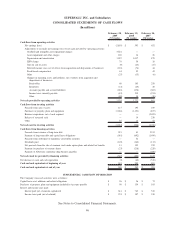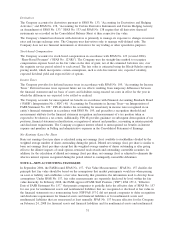Albertsons 2009 Annual Report Download - page 55
Download and view the complete annual report
Please find page 55 of the 2009 Albertsons annual report below. You can navigate through the pages in the report by either clicking on the pages listed below, or by using the keyword search tool below to find specific information within the annual report.Derivatives
The Company accounts for derivatives pursuant to SFAS No. 133, “Accounting for Derivatives and Hedging
Activities,” and SFAS No. 138, “Accounting for Certain Derivative Instruments and Certain Hedging Activity,
an Amendment of SFAS No. 133.” SFAS No. 133 and SFAS No. 138 require that all derivative financial
instruments are recorded on the Consolidated Balance Sheet at their respective fair value.
The Company’s limited involvement with derivatives is primarily to manage its exposure to changes in interest
rates and foreign exchange rates. The Company uses derivatives only to manage well-defined risks. The
Company does not use financial instruments or derivatives for any trading or other speculative purposes.
Stock-based Compensation
The Company accounts for stock-based compensation in accordance with SFAS No. 123 (revised 2004),
“Share-Based Payment” (“SFAS No. 123(R)”). The Company uses the straight-line method to recognize
compensation expense based on the fair value on the date of grant, net of the estimated forfeiture rate, over
the requisite service period related to each award. The fair value is estimated using the Black-Scholes option
pricing model, which incorporates certain assumptions, such as risk-free interest rate, expected volatility,
expected dividend yield and expected life of options.
Income Taxes
The Company provides for deferred income taxes in accordance with SFAS No. 109, “Accounting for Income
Taxes.” Deferred income taxes represent future net tax effects resulting from temporary differences between
the financial statement and tax basis of assets and liabilities using enacted tax rates in effect for the year in
which the differences are expected to be settled or realized.
The Company accounts for unrecognized tax benefits in accordance with Financial Accounting Standards Board
(“FASB”) Interpretation No. (“FIN”) 48, “Accounting for Uncertainty in Income Taxes—an Interpretation of
FASB Statement No. 109.” FIN 48 clarifies the accounting for uncertainty in income taxes recognized in an
entity’s financial statements in accordance with SFAS No. 109, and prescribes a recognition threshold and
measurement attribute for the financial statement recognition and measurement of a tax position taken or
expected to be taken in a tax return. Additionally, FIN 48 provides guidance on subsequent derecognition of tax
positions, financial statement reclassification, recognition of interest and penalties, accounting in interim periods
and disclosure requirements. The Company recognizes interest related to unrecognized tax benefits in Interest
expense and penalties in Selling and administrative expenses in the Consolidated Statement of Earnings.
Net Earnings (Loss) Per Share
Basic net earnings (loss) per share is calculated using net earnings (loss) available to stockholders divided by the
weighted average number of shares outstanding during the period. Diluted net earnings (loss) per share is similar to
basic net earnings (loss) per share except that the weighted average number of shares outstanding is after giving
effect to the dilutive impacts of stock options, restricted stock awards and outstanding convertible securities. In
addition, for the calculation of diluted net earnings (loss) per share, net earnings (loss) is adjusted to eliminate the
after-tax interest expense recognized during the period related to contingently convertible debentures.
NOTE 2—NEW ACCOUNTING STANDARDS
In September 2006, the FASB issued SFAS No. 157, “Fair Value Measurements.” SFAS No. 157 clarifies the
principle that fair value should be based on the assumptions that market participants would use when pricing
an asset or liability and establishes a fair value hierarchy that prioritizes the information used to develop those
assumptions. Under SFAS No. 157, fair value measurements are separately disclosed by level within the fair
value hierarchy. In February 2008, the FASB approved FASB Staff Position (“FSP”) FAS 157-2, “Effective
Date of FASB Statement No. 157,” that permits companies to partially defer the effective date of SFAS No. 157
for one year for nonfinancial assets and nonfinancial liabilities that are recognized or disclosed at fair value in
the financial statements on a nonrecurring basis. FSP FAS 157-2 did not permit companies to defer recognition
and disclosure requirements for financial assets and financial liabilities or for nonfinancial assets and
nonfinancial liabilities that are remeasured at least annually. SFAS No. 157 became effective for the Company
on February 24, 2008 for financial assets and financial liabilities and for nonfinancial assets and nonfinancial
51
























